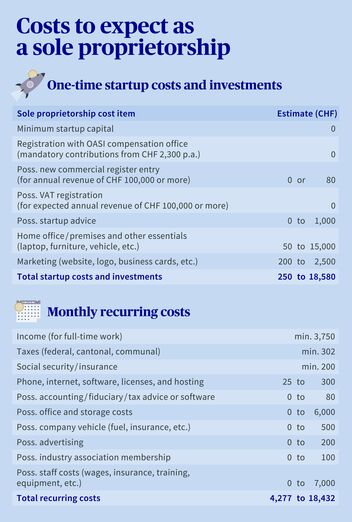
Self-employed in Switzerland: Cost overview
Do you want to ensure your financial security even while self-employed? From startup capital to retirement – we answer your questions about the main financial hurdles.
When you become self-employed, it’s important to know if you will be able to support yourself financially. Do I have enough startup capital? How can I remain financially independent over the long term? How can I save for retirement? Whether you have questions about starting your company, insurance or securing your future retirement, here you will find the answers to the main questions on how to ensure your financially security while self-employed.
The most frequently asked questions about financial independence
Who is considered to be self-employed in Switzerland?
Sole proprietors and partners of a business partnership (general partnership or limited partnership) are considered to be self-employed persons. From the point of view of Swiss social insurance, anyone who works on their own behalf and for their own account and bears the financial risk of doing so is self-employed.
The owners and managing directors of a limited liability company (GmbH/Sàrl) or stock corporation (AG/SA) are employed by their own company. For this reason they are not considered to be self-employed.
How much starting capital do I need to become self-employed?
Forming a sole proprietorship does not cost a lot. As with a general partnership, there is no minimum investment required to set up a sole proprietorship. You only need CHF 80 to make the necessary entry in the commercial register. If you’d like a consultation on the different options for setting up a company, then you should budget up to CHF 1,000.
In addition to the startup costs, you also need to consider the investment costs. Do you have too little cash to cover these costs and can’t get a loan to cover your startup costs? One option available to you within the first year is to use your Pillar 3a savings so you can save your equity.
What costs can I expect when I become self-employed?
Self-employed costs are made up of formation costs, investment costs and operating costs. The following example demonstrates the individual costs involved in setting up your own company.
Example: How much does it cost to become self-employed?
The actual cost of becoming self-employed can vary enormously. Someone who starts up an online shop from their home office will need far less money than someone who opens a boutique downtown.
Still, we want to give you a rough idea of the actual costs involved in becoming self-employed. Our cost example is an estimate of the expenses for a sole proprietorship with a small furnished office. The estimate focuses on the startup year. Regarding salary and staff, we assume that the founder will work full-time in the beginning and has a part-time employee who works 20 hours a week.

Click here to download the cost overview to use as a checklist for self-employed persons in Switzerland free of charge. This way you can keep the expenses for your independent company under control and grow your financial independence at the same time.
Have you already entered your out-of-pocket expenses? Congratulations! You have completed the first step in your financial planning.
What is financial planning?
Financial planning is a key element in a business plan. It shows you the economic feasibility of your business idea: Is it good enough to finance your starting costs and to generate a profit long term?
- First calculate your costs. The formation costs and the operating costs serve as the starting point for your financial planning. Calculate your operating costs as precisely as you can in your financial planning. Until your company starts making a profit, you will have to finance both its operation and yourself. Generally it takes several years before an independent business becomes profitable.
- In the second step you will plan your revenue. This will give you an idea of the liquidity and profitability. Consider various scenarios (optimistic, neutral and pessimistic).
A good financial plan will give you an idea of how much revenue your company will have to take in and how much profit will remain after taxes and fees. This means you have access to sufficient capital right from the start and are able to request funding in good time – regardless of whether you need a bank loan or other borrowed capital to finance your business idea.
Should you fund your business yourself or borrow?
Formation, financing a concept or growth: Whether it’s better to borrow or use your own money depends on the industry and the individual company. The optimum ratio for raising capital can change depending on what phase your company is in. There are also other options besides bank loans. The main financing options are:
- Equity: This is vital to people starting a company – particularly in the early phase. It can include savings, pension fund withdrawals, individual retirement accounts and external investors who invest in the company. The three most popular sources for funding are the 3 Fs: Family, Friends and Fools.
- Borrowed capital: This money generally comes from a bank in the form of a bank loan. The bank requires an established business and collateral before providing credit. Credits and loans can also come from individuals. However, this does not make them a co-owner of the company.
- Business angels and venture capitalists: They provide the company with equity during the initial startup phase. Startups benefit from business angels and venture capitalists twice over: In addition to providing funding, they give young entrepreneurs advice and share their expertise.
- Foundations and prize money: It takes a lot of funding to start a company. In Switzerland, there are numerous foundations and prizes for young entrepreneurs that promote certain new companies.
- Crowdfunding: A large number of private individuals pay small amounts to an online platform to fund the startup’s first projects. There are various types of crowdfunding: crowd donations, crowd lending, crowd investing and reward-based crowdfunding (which offers goodies or prototypes in return for the startup donation).
Can I take money out of my retirement savings to fund my self-employment?
Yes. You can use the money you’ve saved in your Pillar 2 (OPA occupational benefits) to help fund your self-employment. To do this, the following conditions need to be met:
- You submit the application for the withdrawal within the first year after starting your company.
- You prove that you are self-employed, such as with your OASI documents or an extract from the commercial register.
- Are you married / live in a registered partnership? Then you need to submit the agreement of your spouse / partner with the application for the pension fund payout.
Contact your pension fund for more information about withdrawals.
How can I withdraw my Pillar 3 savings?
If you want to withdraw the savings from your Pillar 3a account (restricted individual retirement account) to fund your self-employment, you will have to pay out your entire savings into that account and pay tax on it.
There are no restrictions on withdrawals from your Pillar 3b account (unrestricted individual retirement account). You can withdraw your savings at any time.
Contact your occupational benefits institution for more information on using your Pillar 3 savings.
How do I figure out what salary to pay myself?
The earnings from your self-employment equal the taxable income of your sole proprietorship. Which in turn equals your company profit (also called net profit).
As the owner of a sole proprietorship, the company profit automatically becomes your salary. In accounting, it is declared as a personal withdrawal since you are not actually an employee.
What is net income when you are self-employed in Switzerland?
Net income is equal to the annual earned income for self-employed persons. You will need it to calculate your taxes, for instance.
How much revenue do I need as a self-employed person?
The amount of revenue you will need depends on many factors. Figure out what personal and business costs you have for each month. Incidentally, a rule of thumb you can use is that when you are self-employed, your turnover needs to be two to three times the net salary from your previous job.
How do I calculate my hourly wage?
How much is my work worth?
- Calculate your hourly wage based on your business and living costs. This includes, among other things, expenses for rent, electricity, water, heating, food, insurance as well as for family and leisure activities.
- Divide your monthly business and living expenses by the number of hours you spend working at your business every month.
- At the least, your hourly wage needs to cover these business and living expenses, provided that you work full time and have no other sources of income.
- When calculating your hourly wage, take into account any work absences related to sickness and vacation as well as your 13th month’s salary. To do this, you can reduce the number of monthly target working hours accordingly.
Finding the right number of working hours is a balancing act:
- If your hourly wage is too high, you may not receive any projects at first.
- Set your wage too low, and you will be selling yourself short.
- To help you set a price, a wage calculator for similar industries and jobs can be useful. Sounding out your business network is also a good idea.
How do I figure out the profit I’ve earned from being self-employed?
To calculate your profit, you need two figures, each covering the same period:
- The income from your business = total income
- All business expenses (contributions, rent, costs, etc.) = total business expenses
Now deduct your total business expenses from your total income, and this will give you your income from self-employment. This equals your profit for the relevant time period.
Do self-employed people need to keep accounts?
Yes. If the revenue of a sole proprietorship is less than CHF 500,000, you have to keep accounts of your income, expenditure and assets at the least.
If your sole proprietorship takes in over CHF 500,000, then you are required to keep accounts and make financial reports as per the rules defined under the Swiss Code of Obligations (SCO 957 et seq.).
As a self-employed person, what contributions am I required to pay?
- In Switzerland, self-employed persons are required to pay into OASI/DI/LEC. The contributions are based on the income you earned during the contribution year.
- Family allowance contributions are made in addition to this. You must join a family compensation fund. These are generally administered by the OASI compensation fund.
- Depending on what industry you are in, professional liability insurance may be mandatory.
- Paying taxes and private health insurance is also essential.
What financial risks do I run as a self-employed person?
- Orders could be few and far between or might be canceled.
- Invoices may not be paid by your clients.
- As the owner of a sole proprietorship, all of your personal assets are exposed, even if you declare bankruptcy.
- Self-employed people in Switzerland can’t register with the state unemployment insurance program, so they aren’t insured against unemployment.
- Nor is it mandatory for them to be insured against accidents.
- If you do not voluntarily pay into the second and / or third pillars, you are not proactively saving for your old age.
How can I protect myself financially when I’m self-employed?
- Sickness and accidents: As a self-employed person, you can include daily accident benefits in your daily sickness benefits insurance or voluntarily buy AIA accident insurance. But your personal health insurance can also provide this coverage. If you become sick or have an accident, it will make up for your lost income.
- Disability: You can get additional coverage from a private insurer for disability. Additional options: Increased benefits from your pension fund or a Pillar 3a retirement solution with insure yourself against the risks of death and disability can also be included in these policies.
- Death: You should also have insurance in case you die. Insurance companies offer many different solutions.
- State pensions: Try to avoid gaps in your OASI contributions (Pillar 1).
- Occupational benefits: In order to supplement the OASI minimum benefits, it’s worth joining a Pillar 2 pension fund for self-employed persons.
- Restricted pension funds: Many self-employed people in Switzerland take out a Pillar 3 private retirement account with a view to maintaining the standard of living they’re accustomed to after they retire. This type of retirement savings lets you pay in larger contributions (if you are not a member of a pension fund) and enjoy tax advantages. You should take advantage of investing in provident funds, but make sure to follow your investment strategy when you do.
- Unrestricted pension funds: With a long-term ETF savings plan with a large equity component, you will benefit from the return opportunities afforded by the capital markets without having to worry about market interest rates. You have more withdrawal options in contrast to pension funds with limits on contributions and withdrawals.
What is the maximum Pillar 3a contribution for self-employed persons?
Self-employed persons who must pay OASI but are not in a pension fund can pay up to 20 percent of their net earned income into a Pillar 3 restricted fund. The maximum contribution you can make to Pillar 3 for 2025 is CHF 36,288. As you do not belong to a pension fund, then in addition to investing, you should also insure yourself against being unable to work due to sickness, accident and death.
How does a second job affect my Pillar 3a account?
If you are self-employed and have a side job as well, then you are considered to be an employee. This means you can contribute a maximum of CHF 7,258 (2025 limit) into your Pillar 3 account since you are enrolled in a pension fund.
What pension fund can I join as a self-employed person?
Since you are self-employed, you are no longer required to pay into a Pillar 2 pension fund. However, you can voluntarily insure yourself so you can accumulate pension fund savings to insure against the risks of death, disability and old age (Art. 4 OPA). There are various options to choose from:
- Join the occupational benefits institution of an occupational/industry association (Art. 44 (1) OPA). These are usually joint foundations.
- If you are not required to join a pension fund and don’t belong to an occupational benefits institution, then you can join the BVG National Substitute Pension Plan Foundation (Art. 44 (2) OPA).
- Do you have employees who are subject to mandatory insurance? They must join an occupational benefits institution entered in the occupational benefits register (Art. 11 (1) OPA).
Their vested benefits can then be transferred to the new pension fund.
Is it a good idea to join a pension fund if I’m self-employed?
Does your business support your family? Then offer your loved ones some extra security by making OPA contributions into a Pillar 3 account in addition to your regular savings. This will allow you to maintain your whole family’s usual standard of living if you’re unfit for work due to sickness or an accident.
And paying into a pension fund is a means of saving money. You can deduct these contributions from your taxable income as well as any income that is subject to OASI contributions. So not only are you saving for retirement, you’re also paying less in OASI and taxes.
Summary: Five financial tips for the self-employed
Admittedly, it will take some time for you to really understand your finances. But once you get started, you will quickly get a handle on your costs and revenue. These five financial tips for the self-employed will help you build up a financial safety net and financial independence.
- Separate your personal and business accounts: A separate business account gives you a quicker overview of your income and expenses because it only contains business transactions.
- Plan your finances: If you have a good overview of your spending and revenue, then you can manage your profitability in a targeted manner.
- Build up reserves: Taxes, misbudgeted contributions or times of crisis – if you start putting aside money early on, then you will have something to fall back on if times get tough or to cover unexpected expenses.
- Insure yourself properly: In addition to mandatory insurance, find out which coverages make sense for your business. A personal insurance checkup is also helpful.
- Save for your retirement: When you are self-employed, you alone are responsible for your retirement savings. Read up on the different options available for Pillar 2 and Pillar 3 retirement accounts. There are some great offers that you can tailor to meet your personal and professional needs.
We are here to support you along every step of your journey into self-employment. Good luck!










